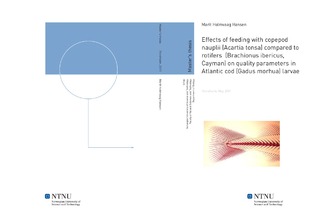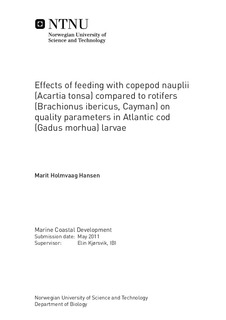| dc.description.abstract | Good nutritional quality is a key for a successful Atlantic cod (Gadus morhua) juvenile producer. Copepods are the natural prey for marine fish larvae, and its nutritional composition is believed to be optimal for the marine fish larvae. Despite the suitability for copepods in cod cultivation, only a few hatcheries have used this technique. When cultivating cod larvae and copepods intensively they can be produced in larger quantities and year-round, compared to the seasonal extensive cultivation. Intensive produced copepods have yet to be used in large-scale cod hatcheries. It has several times been documented that nutrition is important for survival, growth and the general quality of cod larvae. Even though these variables are something many farmers of juvenile cod (Gadus morhua) are struggling with, there has still not been developed any standard evaluation of quality. Codeggs were divided and after hatching given 4 different feeding regimes (3-28 dph). One was fed the copepod Acartia tonsa, a second fed the rotifer Brachionus ibericus enriched, a third fed Brachionus ibericus unenriched and a last with a mixture of copepods (7 days) and enriched rotifers. This was done to better see the effect of copepod feeding compared to the rotifer effect, and if there could be some benefits from only feeding with copepods for a small period. All treatments were fed Artemia sp. (20-40 dph) and dry feed (36-60 dph). In addition to growth and survival, the quality of the fish larvae was assessed. This was done by using the following quality parameters: Larval feeding activity, resistance to handling stress, skeletal deformations and shape variation.The study showed a clear trend where the larvae fed mostly copepods were the most successful in terms of growth, survival and quality, followed by those fed copepods for 7 days, and enriched and unenriched rotifers at the end. These results clearly showed that intensively cultivated copepods successfully could be used during intensive cod cultivation. All quality parameters gave results and combined gave a broad picture of the general quality of the cod larvae. | nb_NO |

